What is a wart? We will analyze the causes, diagnosis and methods of treatment in an article by a dermatologist with 37 years of experience.
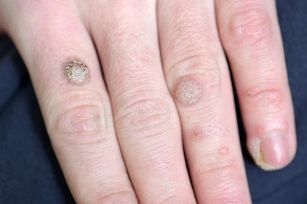
Definition of the disease. Causes of the disease
Wartsare mild, irregular benign skin lesions in the form of a localized overgrowth of the upper layer of the skin (epidermis) with papules (nodules) or plaques.
The incidence of warts in adults is 7-12%, in school-aged children - up to 10-20%.
Warts are very similar to other skin growths. Usually, a person cannot accurately determine the disease on their own, so a dermatologist must be consulted for a diagnosis.
The human papillomavirus is the cause of warts. The type of virus affects the type of warts that can develop. Thus, each type of human papillomavirus infects tissues at the most characteristic location.
| HPV type | Preferred location |
Types of warts |
|---|---|---|
| 1 | Feet, knees, palms, hands, fingers |
Plantar and palmar warts, rarely simple warts |
| 2, 4 | Hands, fingers, knees, less often - feet |
Simple warts, sometimes plantar warts, palmar and mosaics |
| 3, 10 | Shins, hands, face | Flat warts |
| 7 | Hands, fingers | Butcher's warts |
| 5, 8, 9, 12, 14, 15, 17, 19-24 |
Face, arm, front torso |
Verruciform epidermodysplasia |
Infection with the virus usually occurs through contact - through direct contact with infected, healthy skin (eg, by shaking hands) or indirectly (through handrails, toys, etc. ). Therefore, you can become infected with the human papillomavirus, which causes warts, in a wide variety of places - on public transport, at school, at work, at home, in places with high contact andin a humid environment (swimming pools, saunas, gymnasiums). Small traumas to the epidermis through which viruses enter, as well as inflammation of the skin, contribute to infection.
Also contributing to the appearance of warts:
- immune deficiencies (including HIV infection);
- hot and humid environment;
- the need for professional contact with meat and fish (“butcher's warts”).
Some types of human papillomavirus are transmitted from parents.
But toads and frogs, despite the horror stories we so often fear in childhood, cannot be infected - this is one of the most common myths about this disease, which is'has no basis.
If you find similar symptoms, see your doctor. Don't self-medicate - it's dangerous for your health!
Symptoms of warts
Symptoms vary depending on the type of wart.

Common wart:
- Dense round papule of normal color, 1-10 mm and larger.
- The surface of the papule is covered with cracks, layers.
- If the papule is on the finger, the impression disappears and is distorted. The same goes for the palm design.
- Simple warts are localized individually or in several pieces - they usually appear in the most injured places (hands, fingers, knees).
- When viewed with a dermatoscope, the doctor may see small brown dots - thrombosed (clogged) capillaries. Patients often call these points “roots”. This is the main sign for a doctor: it can be used by a dermatologist to distinguish a wart from other similar diseases (for example, molluscum contagiosum and keratoma).
Plantar wart (cornea):
- The main symptom that usually causes a patient to see a doctor is pain when pressing and walking.
- These warts are usually located on the feet.
- When you contact a doctor, as a rule, an uneven keratin plaque of the usual color is visible, although at the first stage you can see a uniform, smooth papule. With keratinization, the capillaries are only visible if the keratinized layer of the skin is removed.
- The sole skin pattern is distorted.
- Plantar warts are usually solitary, but there are also 2-6 warts;
- these warts are often confused with corn (especially dry) - this is the description of the problem that patients usually come to see.
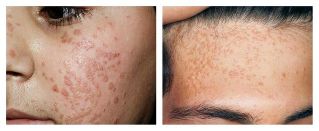
Flat wart (juvenile):
- It looks like a round, clear and smooth papule of normal color, pink or brownish, 1 to 5 mm.
- Appears on the hands, shins, very often on the face.
- There are always several such warts - they are located in clusters.
Verruciform epidermodysplasia (senile wart):
- Large, round and numerous confluent tumors, normal pink or brown in color.
- Most often appear on the face, arms, front of the torso.
- May be confused with keratoma, shingles, and skin cancer.
Pathogenesis of warts
When it enters the body, the human papillomavirus can be in a latent state for a long time - a person usually does not even know of its existence. When favorable factors for the virus appear, it begins to "multiply" in the epithelium, causing tissue changes.
Unlike other viruses, the human papillomavirus does not destroy the cells of the epithelium itself - they die on their own, naturally, during the process of keratinization and desquamation.
Local factors and the state of the immune system affect the spread of infection. For example, people who are infected with HIV or have had a kidney transplant are more likely to develop warts. In addition, these neoplasms are often difficult to treat. With normal immunity, the virus does not affect the deep layers of the skin, so many people get warts on their own after a few months.
The main stage in the appearance of warts is the acceleration of the rate of cell division and growth with the help of the virus. This rapid metabolism leads to thickening of the skin layers. As the tissue grows in a certain small area, a tubercle appears, called a wart.
Classification and stages of wart development
There is no universally accepted classification for warts. However, there are several common varieties:
- The common wartis the most common type (70% of warts are just them). Such neoplasms are not felt and only cause cosmetic discomfort to a person.
- Plantar wart- appears on the soles of the feet, is painful, therefore requires treatment. Trauma to the skin caused by uncomfortable, tight, rubbing shoes contributes to the development of such a wart.
- Flat warts- appear more often in young people, adolescents. This is due to the unstable hormonal background of young people, which affects the whole body. Flat warts are usually almost invisible.
- Senile warts- are typical of older people. They often appear on the part of the body that is covered with clothing, but can appear on the face and hands. If there is no discomfort, these warts should not be treated - healing in older people can be much slower than in younger people, due to slow metabolism.
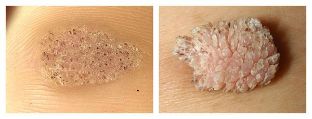
Other authors distinguish several others from these types of warts:
- Mosaic warts(HPV 2, 4) - neoplasms on the palms and soles of the feet. They look like foci of hyperkeratosis, that is, thickening of the stratum corneum (usually in the forefoot), covered with deep cracks.
- Cystic warts(HPV 60) are a very rare type of growth on the foot. It is a soft knot with cracks. Upon opening, a white-yellow discharge looks like curd.
- Filiform wartsare thin, horny growths near the mouth, nose, or eyes.
- "Butchery" warts(HPV 7) - appear on the hands and fingers of people who are in constant contact with meat and fish. Presented as enlarged neoplasms similar to cauliflower, but normal in color.
Additionally, types of warts are distinguished based on their location.
For example, anogenital warts - tumor-like neoplasms that appear on the genitals (especially where the skin passes to the mucous membrane) is a common disease. They are usually caused by HPV types 6 and 11.
Complications of the wart
The main reason why warts patients go to the doctor is because of a cosmetic defect which can affect the patient's quality of life, self-confidence and develop many complexes. Complications include cracking of the wart surface and adding infection, and in some types of warts, pain when walking.
Skin warts usually do not degenerate into malignant neoplasms, they are quite harmless, however, in very rare cases such a complication can still occur in people with suppressed immunity.
Other complications arise when you try to eliminate the growth on your own. In this regard, inflammation and cosmetic defects in the form of scarring may occur, as well as the spread of the virus through the skin, due to which in the morning after self-removal of a wart, a person canwake up with more news.
Remember that under the guise of a wart a completely different disease can be hidden, which cannot be determined without the advice of an experienced doctor.

Diagnosis of warts
An examination (clinical picture) and history (medical history) are usually sufficient to make a diagnosis.
To confirm the diagnosis, the doctor may perform a histological examination - the study of the cells of the neoplasm.
It is very important to perform a differential diagnosis - to distinguish warts from other diseases. For example,common wartsshould be distinguished from the following diseases:
- Molluscum contagiosum- appears more often on the body and genitals, less often on the hands and feet. It is a hemisphere with an imprint on the surface; when squeezed from the sides, a whitish "oatmeal" is released.
- Epidermal verrucous nevus- more often solitary a person has from birth. It rises above the surface of the skin, often covered with hair.
- Basalioma- a tumor in the form of a roll of nodules, covered with a crust in the center. Typical for the elderly.
Palmoplantar wartsshould be distinguished from the following diseases:
- Keratoderma- large areas of keratinization and inflammation of the skin. No coagulated capillaries.
- Palmoplantar syphilides- multiple painless neoplasms, the skin exfoliates along the periphery. The reaction to syphilis is positive.
- Corn- usually painless, can only cause pain when pressed vertically.
The doctor must also differentiate other types of warts from a number of diseases. If another pathology is suspected, he may order additional diagnostics (for example, detection of antibodies against viruses, CT or MRI).
Warts treatment
Warts are treated for cosmetic purposes and to improve the patient's quality of life. It can only be prescribed by a doctor after an examination and a correctly diagnosed diagnosis. Independent attempts to get rid of a wart are unacceptable, since a patient without medical training and the necessary equipment is not able to accurately determine the disease, and complications after such "treatment" occur a lot. more often than healing.
There are several ways to treat warts. All are usually done under the supervision of a doctor, and some of them - only in the treatment room of the clinic.

Chemical treatments
Milk-salicylic collodion and salicylic patches are used to get rid of the wart. The percentage of drugs and their mode of use (prolonged wearing of plasters, applications, etc. ) depend on the prevalence and location of the neoplasm.
Zinc and 2-chloropropionic acid solutions can also be used. In this case, a chemical composition is applied to the pretreated surface, which is left on the wart until the color changes (depending on the type of wart). The procedure is repeated several times after 7, 14 and 21 days. Before each intervention, the tissue is removed mechanically.
Another chemical method is a combination of nitric, acetic, oxalic, lactic acids and copper nitrate trihydrate. In this way, only relatively small neoplasms are treated - up to 5 mm. The solution is also left to change the color of the wart. After 3 to 5 days, the patient comes for a follow-up appointment, if necessary, a second procedure is prescribed for him in 1 to 4 weeks.
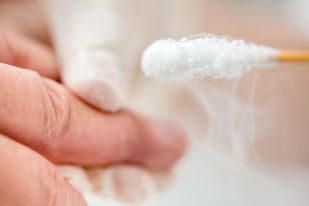
Cryodestruction
This method consists of freezing the wart with liquid nitrogen: a moistened swab is pressed against the damaged skin (with capture of the surrounding tissues of a few mm) for 1 to 5 minutes. Some lesions require several treatments four weeks apart to be destroyed.
The main disadvantages of cryodestruction are its pain and delayed effect compared to other methods, where one procedure is often sufficient for removal.
Electrocoagulation
Under the influence of an electric current, the wart is removed in layers. Such an operation is performed under local anesthesia.
This method is more effective than cryodestruction, but it has a major drawback - electrocautery often leaves scars at the site of wart removal. For patients seeking cosmetic repair,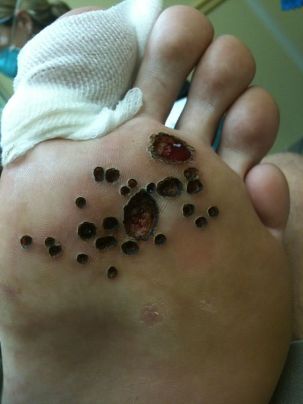 this method will not be the most appropriate.
this method will not be the most appropriate.
Laser destruction
The laser also removes layered warts. The light guide comes into contact with the skin for a few seconds to three minutes, depending on the size. Then the crust that appears is excised and the bottom of the wound is again treated with a laser. The patient is then given instructions on how to treat the wound. The operation itself is performed under the influence of local anesthesia.
Radio wave surgery
Radio wave surgery is one of the most modern and gentle methods of removing some benign tumors, including warts.
The method is based on the generation of electromagnetic waves with different frequencies: from 100 kHz to 105 MHz. During the procedure, the tissues resist the passing waves, which is why molecular energy is released in the cells, which heats the skin. Under the influence of heat, cells actually evaporate - a clean cut is obtained. At the same time, no mechanical force is exerted on the affected tissue.
Advantages of this method:
- security;
- rapid wound healing;
- good cosmetic effect - scars and scars are excluded;
- relatively painless - local anesthesia is applied before mini-surgery;
- exclusion of secondary infection due to automatic disinfection of the electrode when switching on the device.
The effectiveness of this method is recognized around the world, however, it is quite difficult to find a clinic that uses the method of radio wave surgery.
Which treatment method to choose
All of the above methods have several drawbacks:
- In the first two weeks, the operated area looks unattractive - scabs, darkening of the tissues. This should be taken into account if warts are found on visible parts of the body (eg on the face).
- Unpleasant odor and some degree of pain during surgery.
In addition, each of these methods has contraindications, which you should be aware of during a prior consultation with a dermatologist.
But the main drawback is thehigh probability of recurrence, especially if the warts were widespread, extensive. With each of these methods, doctors do not fight the root cause of the disease, but with its consequences, since todayhuman papillomavirus cannot be cured.
Therefore, therapy is directed to:
- or destruction of neoplasms that appear at the site of introduction of the virus;
- either to stimulate the antiviral immune response;
- or a combination of these approaches.
Most often, destructive processing is used. Their efficiency reaches 50 to 80%.
Childhood is generally not a contraindication to surgical treatment. Therefore, many of them (including radio wave surgery) are also used to treat warts in children. An exception is the chemical removal of warts due to the possibility of adverse reactions to the substance.
What to do after the operation
Be sure to follow your doctor's advice after any of these operations.
After the tumor has been removed by one of the methods presented, the doctor usually prescribes treatment for the removal site. It is forbidden to remove the "scabs" yourself, to wet the wound and to expose it to direct sunlight.
If a patient is constantly suffering from warts, then he should consult an immunologist - perhaps drug therapy will be required, which will increase the resistance of immunity to manifestations of human papillomavirus.
Forecast. Prevention
If the patient does not have an immune deficiency, the warts may go away on their own, but it will take a long time - from several months to several years. Thus, in 65% of cases, the warts regress independently in two years. If after two years the wart is still in place, it is recommended to remove it. It is recommended that you remove multiple growths immediately.
With normal immunity and the correct method of removal (depending on the size and type of the wart), it is possible to remove pathogenic tissue and achieve a good cosmetic effect. With reduced immunity and other predisposing factors, the human papillomavirus remaining in the body causes relapses.
There is no specific disease prevention. But is infection inevitable?
You can reduce the likelihood of a virus if you follow a few rules:
- Avoid walking barefoot in public places where there is a risk of skin injury and viral infection (swimming pools, public showers, gyms).
- Choose quality shoes, change them often. Try to keep your feet dry. Heat and humidity are excellent breeding grounds for the human papillomavirus.
- To prevent periungual warts, visit only certified nail technicians and make sure they use sterile instruments.
For the prevention of anogenital warts, according to the WHO (World Health Organization), the quadrivalent vaccine against human papillomavirus is also very effective. There is currently no vaccine available to prevent other types of warts.
If you find a wart, don't try to cauterize, cut, or remove it yourself - this way you can contribute to inflammation and the virus spreading through the skin. After such an "elimination", instead of a wart in the morning, you can wake up with ten.














































































